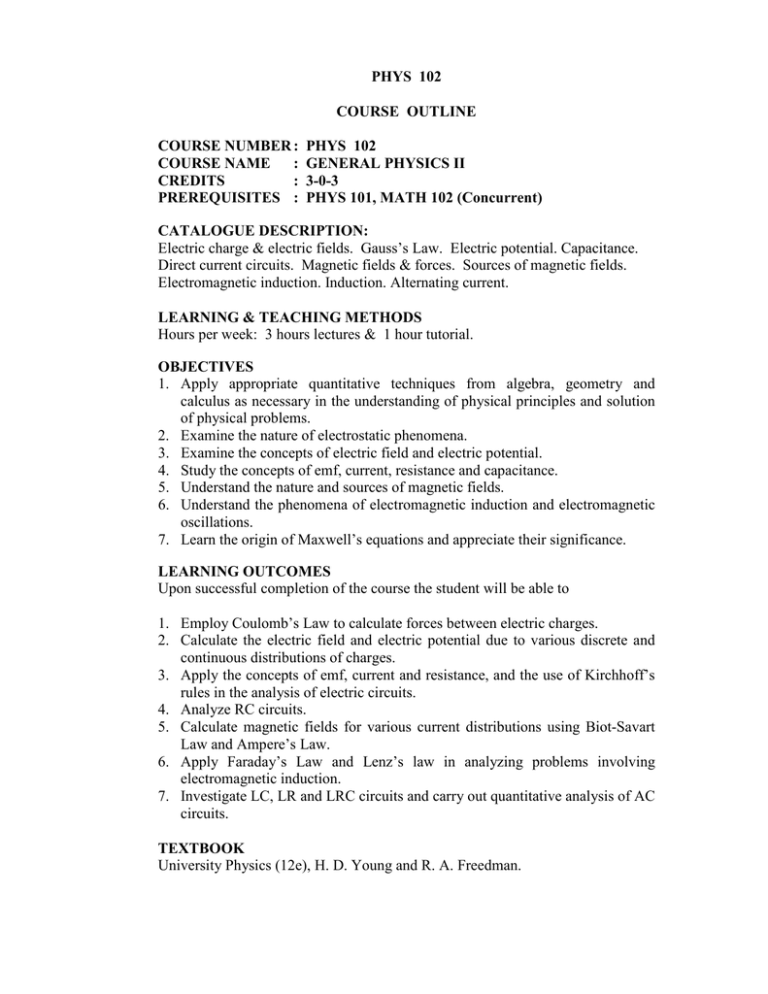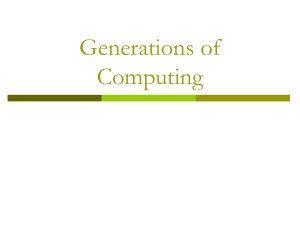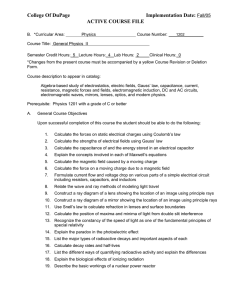PHYS 102 - Kuniv.edu.kw
advertisement

PHYS 102 COURSE OUTLINE COURSE NUMBER : COURSE NAME : CREDITS : PREREQUISITES : PHYS 102 GENERAL PHYSICS II 3-0-3 PHYS 101, MATH 102 (Concurrent) CATALOGUE DESCRIPTION: Electric charge & electric fields. Gauss’s Law. Electric potential. Capacitance. Direct current circuits. Magnetic fields & forces. Sources of magnetic fields. Electromagnetic induction. Induction. Alternating current. LEARNING & TEACHING METHODS Hours per week: 3 hours lectures & 1 hour tutorial. OBJECTIVES 1. Apply appropriate quantitative techniques from algebra, geometry and calculus as necessary in the understanding of physical principles and solution of physical problems. 2. Examine the nature of electrostatic phenomena. 3. Examine the concepts of electric field and electric potential. 4. Study the concepts of emf, current, resistance and capacitance. 5. Understand the nature and sources of magnetic fields. 6. Understand the phenomena of electromagnetic induction and electromagnetic oscillations. 7. Learn the origin of Maxwell’s equations and appreciate their significance. LEARNING OUTCOMES Upon successful completion of the course the student will be able to 1. Employ Coulomb’s Law to calculate forces between electric charges. 2. Calculate the electric field and electric potential due to various discrete and continuous distributions of charges. 3. Apply the concepts of emf, current and resistance, and the use of Kirchhoff’s rules in the analysis of electric circuits. 4. Analyze RC circuits. 5. Calculate magnetic fields for various current distributions using Biot-Savart Law and Ampere’s Law. 6. Apply Faraday’s Law and Lenz’s law in analyzing problems involving electromagnetic induction. 7. Investigate LC, LR and LRC circuits and carry out quantitative analysis of AC circuits. TEXTBOOK University Physics (12e), H. D. Young and R. A. Freedman. TOPICS OF THE COURSE 1. ELECTRIC CHARGE a) Properties of electric charge. b) Forces between electric charges and Coulomb’s law. 3 hours 2. a) b) c) d) e) f) 4 hours ELECTRIC FIELDS Definition of electric field. Electric field lines Calculation of electric fields. due to discrete distributions of charge due to continuous distributions of charge Motion of a charged particle in an electric field. 3. GAUSS’S LAW 4 hours a) Electric flux b) Gauss’s Law: heuristic derivation c) Charged isolated conductor d) Applications of Gauss’s Law to planar, cylindrical & spherical symmetries. 4. a) b) c) d) i) ii) e) ELECTRIC POTENTIAL Electrical potential energy Electrical potential Calculating the potential from the field Calculation of electric potential due to discrete distribution of charge due to continuous distribution of charge Electrical potential energy of a system of point charges. 4 hours 5. a) b) c) d) e) CAPACITANCE Calculation of capacitance for various geometries. Capacitors in series and in parallel Energy stored in electric fields. Analysis of effects of dielectrics in capacitors An atomic description of dielectrics. 4 hours 6. a) b) c) d) e) CURRENT & RESISTANCE 3 hours Examination of current, current density, resistance and resistivity. A model of conduction: relation between current density and drift velocity. Variation of resistance with temperature Interpretation of Ohm’s law. Power in electric circuits. 7. a) b) c) DIRECT CURRENT CIRCUITS EMF Analysis of electric networks via Kirchhof’s rules Analysis of RC circuits 8. a) b) c) d) MAGNETIC FIELDS 4 hours Magnetic fields and force Motion of point charge under a magnetic field Motion point charges under crossed electric and magnetic fields; Hall effect. Magnetic force on a current-carrying wire. 9. a) b) c) d) SOURCES OF MAGNETIC FIELDS 4 hours Magnetic field of a point charge Biot-Savart Law and its use for calculation of magnetic fields. Ampere’s Law and applications Force between parallel conductors 3 hours 10. ELECTROMAGNETIC INDUCTION 4 hours a) Use of Faraday’s Law and Lenz’s Law in calculating induced emf’s and currents. b) Motional emf c) Calculation of induced electric fields d) Displacement currents and Maxwell’s equations. 11. INDUCTANCE a) Mutual inductance, self-inductance and inductors. b) Magnetic field energy c) RL, LC & LRC circuits TOTAL 4 hours 41 hours ASSESSMENT The course has four assessment components: 1. Quizzes, homework and/or assignments. : 2. Two midterm exams of 1½ - 2 hour duration. : 3. Comprehensive final exam of 2 hour duration. : 20% 20% each 40% All homework and assignments must be original work of the student. ATTENDANCE REQUIREMENTS Class attendance in lectures and tutorials is essential and may be taken into consideration when borderline grades are reviewed. SUBMISSION OF ASSIGNMENTS All homework and assignments must be submitted by the indicated deadline. Only in exceptional circumstances will late work be accepted or deadline for completing assignments be extended. Penalties will be imposed for late submission as follows: deduction of 10% of the marks for each late day up to a maximum of 3 days. No assignment, for which no extension has been granted, will be accepted after 3 days past the deadline. PLAGIARISM Plagiarism is a serious academic offence. Put simply plagiarism is an action whereby one claims as his own, work or ideas of other people with the intent to deceive. Examples of plagiarism are • • • • • • The use of published or unpublished work of others either as a whole or in parts (such as paragraphs or sentences), which includes books, journal articles, theses, websites, etc., without proper acknowledgement or referencing or without the use of quotation marks. Paraphrasing closely the work of others either as a whole or in parts without proper referencing. Copying computer files without proper acknowledgements. Use or submission of computer programs written by others without authorization. Claiming as your own work executed for you by some other person or agency. Scattering one’s own comments through a text that has been substantially lifted from another source. COURSE COORDINATOR: Dr. Suhel S. Razee



